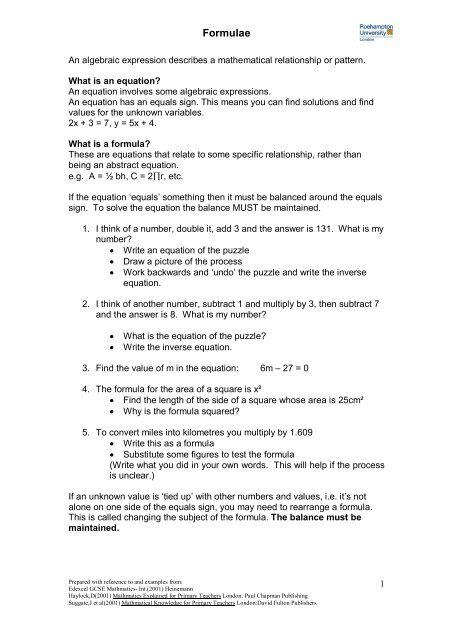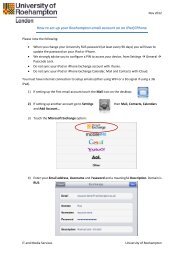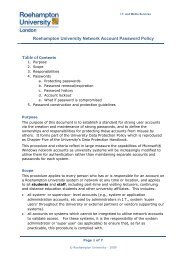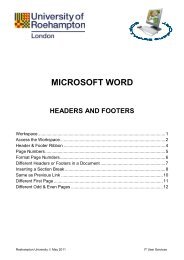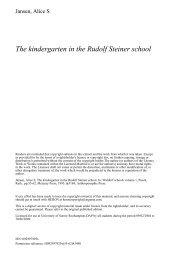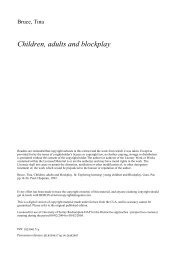Formulae - StudentZone
Formulae - StudentZone
Formulae - StudentZone
Create successful ePaper yourself
Turn your PDF publications into a flip-book with our unique Google optimized e-Paper software.
<strong>Formulae</strong><br />
An algebraic expression describes a mathematical relationship or pattern.<br />
What is an equation?<br />
An equation involves some algebraic expressions.<br />
An equation has an equals sign. This means you can find solutions and find<br />
values for the unknown variables.<br />
2x + 3 = 7, y = 5x + 4.<br />
What is a formula?<br />
These are equations that relate to some specific relationship, rather than<br />
being an abstract equation.<br />
e.g. A = ½ bh, C = 2Õr, etc.<br />
If the equation ‘equals’ something then it must be balanced around the equals<br />
sign. To solve the equation the balance MUST be maintained.<br />
1. I think of a number, double it, add 3 and the answer is 131. What is my<br />
number?<br />
· Write an equation of the puzzle<br />
· Draw a picture of the process<br />
· Work backwards and ‘undo’ the puzzle and write the inverse<br />
equation.<br />
2. I think of another number, subtract 1 and multiply by 3, then subtract 7<br />
and the answer is 8. What is my number?<br />
· What is the equation of the puzzle?<br />
· Write the inverse equation.<br />
3. Find the value of m in the equation: 6m – 27 = 0<br />
4. The formula for the area of a square is x²<br />
· Find the length of the side of a square whose area is 25cm²<br />
· Why is the formula squared?<br />
5. To convert miles into kilometres you multiply by 1.609<br />
· Write this as a formula<br />
· Substitute some figures to test the formula<br />
(Write what you did in your own words. This will help if the process<br />
is unclear.)<br />
If an unknown value is ‘tied up’ with other numbers and values, i.e. it’s not<br />
alone on one side of the equals sign, you may need to rearrange a formula.<br />
This is called changing the subject of the formula. The balance must be<br />
maintained.<br />
Prepared with reference to and examples from:<br />
Edexcel GCSE Mathmatics Int.(2001) Heinemann<br />
Haylock,D(2001) Mathmatics Explained for Primary Teachers London: Paul Chapman Publishing<br />
Suggate,J et al(2001) Mathmatical Knowledge for Primary Teachers London:David Fulton Publishers<br />
1
<strong>Formulae</strong><br />
6. Rearrange the following equations:<br />
a) 3(b+1) = 24 (b)<br />
b) c= ½ d +3 (d)<br />
c) 9m + 4 =3m – 8 (m)<br />
d) a = πr² (r)<br />
7. The formula c= 5/9 (F 32) is used to convert fahrenheit to centigrade.<br />
In order to convert centigrade to fahrenheit it is easier to change the<br />
subject of the formula to F.<br />
Make F the subject and convert 100 degrees centigrade to fahrenheit.<br />
8. Equations often have two unknowns. In the equation t = w + 10<br />
· Find t when w = 5<br />
· Find t when w = 35<br />
· Find w when t = 5<br />
9. In the equation: y = 3x – 5<br />
· Find y when x = 3<br />
· Find y when x = 2<br />
· Find x when y = 10<br />
10.The air temperature T°C, outside an aircraft flying at a height of h feet<br />
is given by the formula:<br />
T = 26 h<br />
500<br />
An aircraft is flying at a height of 27 000ft:<br />
· What is the air temperature outside the aircraft?<br />
· The temperature outside the aircraft is 52°C. What is the height<br />
of the aircraft?<br />
Prepared with reference to and examples from:<br />
Edexcel GCSE Mathmatics Int.(2001) Heinemann<br />
Haylock,D(2001) Mathmatics Explained for Primary Teachers London: Paul Chapman Publishing<br />
Suggate,J et al(2001) Mathmatical Knowledge for Primary Teachers London:David Fulton Publishers<br />
2
<strong>Formulae</strong><br />
For some equations you may need a common solution, these are called<br />
simultaneous equations.<br />
You can solve them by substitution.<br />
Try and find values for x and y in the following example:<br />
y = 2x + 1 and 3y – 4x = 13<br />
Substitute 3 (2x + 1) – 4x =13<br />
Remove brackets 6x + 3 – 4x = 13<br />
Collect like terms 2x + 3 =13<br />
Subtract 3 from both sides 2x = 10<br />
Divide by 2 x = 5<br />
Now find the solution for y by substituting in 5 for x in the first equation<br />
y + 2x + 1:<br />
Substitute x = 5 Y = 2x 5 + 1<br />
Y = 10 +1<br />
Y = 11<br />
Check by substituting the values you have found into the equation containing<br />
both unknowns, in this case x and y.<br />
Correct!<br />
3y – 4x = 3 x 11 – 4 x 5<br />
= 33 – 20<br />
= 13<br />
11.Solve these pairs of equations:<br />
a) y = 27 + 2x and y = 5x<br />
b) y = 40 + 3x and y = 8x<br />
c) y = 25 + 9x and y = 80 + 4x<br />
Prepared with reference to and examples from:<br />
Edexcel GCSE Mathmatics Int.(2001) Heinemann<br />
Haylock,D(2001) Mathmatics Explained for Primary Teachers London: Paul Chapman Publishing<br />
Suggate,J et al(2001) Mathmatical Knowledge for Primary Teachers London:David Fulton Publishers<br />
3
<strong>Formulae</strong><br />
Answers to questions<br />
1) b = 2a + 3<br />
2a + 3 = 131<br />
2a = 131 –3<br />
a = 128/2 a = 64<br />
b – 3 = a<br />
2<br />
2) b = 3(a1) 7<br />
3(a1) – 7 = 8<br />
3(a1) = 15<br />
a1 = 5<br />
a= 6<br />
a = (b + 7) ¸ 3 + 1<br />
3) 6m – 27 = 0<br />
6m = 27<br />
m = 27/6 m = 4.5<br />
4) c 2 = 25<br />
c = Ö25<br />
c= 5 cm<br />
5) M=miles K= Km<br />
K = 1.609M<br />
To get the number of Km<br />
you multiply the number of<br />
miles by 1.609.<br />
6) (a) 3(b+1) = 24<br />
3b + 3 = 24<br />
b = 24 – 3<br />
3<br />
(b) c = ½ d + 3<br />
½ d = c – 3<br />
d = 2(C – 3)<br />
(c) 9m + 4 = 3m – 8<br />
9m = 3m 12<br />
6m = 12<br />
(d) a = Õr 2<br />
r 2 = a<br />
Õ<br />
hhh<br />
r = / a<br />
Ö Õ<br />
7) c = 5/9 (F32)<br />
5/9(F32) = c<br />
F – 32 = 9c<br />
5<br />
F = 9c + 32<br />
5<br />
F = (9 x 100) + 32<br />
5<br />
F = 900/5 + 32<br />
F = 180 + 32<br />
F = 212 degrees fahrenheit.<br />
8) t = w + 10<br />
when w = 5, t = 15<br />
when w = 35, t = 45<br />
when t = 5<br />
5= w + 10<br />
w = 5 – 10, w= 5<br />
9) y = 3x – 5<br />
when x = 3, y = 4<br />
when x= 2, y = 11<br />
when y = 10<br />
10 = 3x –5<br />
3x = 15, x = 5<br />
Prepared with reference to and examples from:<br />
Edexcel GCSE Mathmatics Int.(2001) Heinemann<br />
Haylock,D(2001) Mathmatics Explained for Primary Teachers London: Paul Chapman Publishing<br />
Suggate,J et al(2001) Mathmatical Knowledge for Primary Teachers London:David Fulton Publishers<br />
4
<strong>Formulae</strong><br />
10) T = 26 – (h/500)<br />
T = 26 – (27,000/500)<br />
T = 26 – 54<br />
T = 28 degrees centigrade<br />
T = 26 – (h/500)<br />
T + (h/500) = 26<br />
h/500 = 26 – T<br />
h = 500(26 – T)<br />
h = 13000 500T<br />
h = 13000 (500 x (52))<br />
h = 13000 + 26000<br />
h = 39,000 feet<br />
11)<br />
a) y = 27 + 2x and y = 5x<br />
5x = 27 + 2x<br />
3x = 27<br />
x = 9<br />
y = 5x<br />
y = 5 x 9<br />
y = 45<br />
b) y = 40 + 3x and y = 8x<br />
8x = 40 + 3x<br />
5x = 40<br />
x = 8<br />
y = 8x<br />
y = 8 X 8<br />
y = 64<br />
c) y = 25 + 9x and y = 80 + 4x<br />
80 + 4x = 25 + 9x<br />
5x = 55<br />
x = 11<br />
y = 25 + 9x<br />
y = 25 + (9 x 11)<br />
y = 124<br />
Prepared with reference to and examples from:<br />
Edexcel GCSE Mathmatics Int.(2001) Heinemann<br />
Haylock,D(2001) Mathmatics Explained for Primary Teachers London: Paul Chapman Publishing<br />
Suggate,J et al(2001) Mathmatical Knowledge for Primary Teachers London:David Fulton Publishers<br />
5


